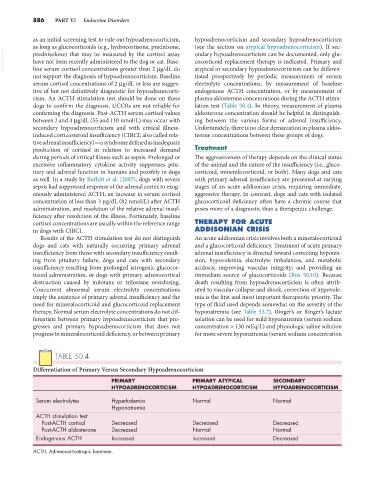Page 914 - Small Animal Internal Medicine, 6th Edition
P. 914
886 PART VI Endocrine Disorders
as an initial screening test to rule out hypoadrenocorticism, hypoadrenocorticism and secondary hypoadrenocorticism
as long as glucocorticoids (e.g., hydrocortisone, prednisone, (see the section on atypical hypoadrenocorticism). If sec-
VetBooks.ir prednisolone) that may be measured by the cortisol assay ondary hypoadrenocorticism can be documented, only glu-
cocorticoid replacement therapy is indicated. Primary and
have not been recently administered to the dog or cat. Base-
line serum cortisol concentrations greater than 2 µg/dL do
tiated prospectively by periodic measurement of serum
not support the diagnosis of hypoadrenocorticism. Baseline atypical or secondary hypoadrenocorticism can be differen-
serum cortisol concentrations of 2 µg/dL or less are sugges- electrolyte concentrations, by measurement of baseline
tive of but not definitively diagnostic for hypoadrenocorti- endogenous ACTH concentration, or by measurement of
cism. An ACTH stimulation test should be done on these plasma aldosterone concentrations during the ACTH stimu-
dogs to confirm the diagnosis. UCCRs are not reliable for lation test (Table 50.4). In theory, measurement of plasma
confirming the diagnosis. Post-ACTH serum cortisol values aldosterone concentration should be helpful in distinguish-
between 2 and 4 µg/dL (55 and 110 nmol/L) may occur with ing between the various forms of adrenal insufficiency.
secondary hypoadrenocorticism and with critical illness- Unfortunately, there is no clear demarcation in plasma aldos-
induced corticosteroid insufficiency (CIRCI; also called rela- terone concentrations between these groups of dogs.
tive adrenal insufficiency)—a syndrome defined as inadequate
production of cortisol in relation to increased demand Treatment
during periods of critical illness such as sepsis. Prolonged or The aggressiveness of therapy depends on the clinical status
excessive inflammatory cytokine activity suppresses pitu- of the animal and the nature of the insufficiency (i.e., gluco-
itary and adrenal function in humans and possibly in dogs corticoid, mineralocorticoid, or both). Many dogs and cats
as well. In a study by Burkitt et al. (2007), dogs with severe with primary adrenal insufficiency are presented at varying
sepsis had suppressed response of the adrenal cortex to exog- stages of an acute addisonian crisis, requiring immediate,
enously administered ACTH, an increase in serum cortisol aggressive therapy. In contrast, dogs and cats with isolated
concentration of less than 3 µg/dL (82 nmol/L) after ACTH glucocorticoid deficiency often have a chronic course that
administration, and resolution of the relative adrenal insuf- poses more of a diagnostic than a therapeutic challenge.
ficiency after resolution of the illness. Fortunately, baseline
cortisol concentrations are usually within the reference range THERAPY FOR ACUTE
in dogs with CIRCI. ADDISONIAN CRISIS
Results of the ACTH stimulation test do not distinguish An acute addisonian crisis involves both a mineralocorticoid
dogs and cats with naturally occurring primary adrenal and a glucocorticoid deficiency. Treatment of acute primary
insufficiency from those with secondary insufficiency result- adrenal insufficiency is directed toward correcting hypoten-
ing from pituitary failure, dogs and cats with secondary sion, hypovolemia, electrolyte imbalances, and metabolic
insufficiency resulting from prolonged iatrogenic glucocor- acidosis; improving vascular integrity; and providing an
ticoid administration, or dogs with primary adrenocortical immediate source of glucocorticoids (Box 50.10). Because
destruction caused by mitotane or trilostane overdosing. death resulting from hypoadrenocorticism is often attrib-
Concurrent abnormal serum electrolyte concentrations uted to vascular collapse and shock, correction of hypovole-
imply the existence of primary adrenal insufficiency and the mia is the first and most important therapeutic priority. The
need for mineralocorticoid and glucocorticoid replacement type of fluid used depends somewhat on the severity of the
therapy. Normal serum electrolyte concentrations do not dif- hyponatremia (see Table 53.2). Ringer’s or Ringer’s lactate
ferentiate between primary hypoadrenocorticism that pro- solution can be used for mild hyponatremia (serum sodium
gresses and primary hypoadrenocorticism that does not concentration > 130 mEq/L) and physiologic saline solution
progress to mineralocorticoid deficiency, or between primary for more severe hyponatremia (serum sodium concentration
TABLE 50.4
Differentiation of Primary Versus Secondary Hypoadrenocorticism
PRIMARY PRIMARY ATYPICAL SECONDARY
HYPOADRENOCORTICISM HYPOADRENOCORTICISM HYPOADRENOCORTICISM
Serum electrolytes Hyperkalemia Normal Normal
Hyponatremia
ACTH stimulation test
Post-ACTH cortisol Decreased Decreased Decreased
Post-ACTH aldosterone Decreased Normal Normal
Endogenous ACTH Increased Increased Decreased
ACTH, Adrenocorticotropic hormone.

